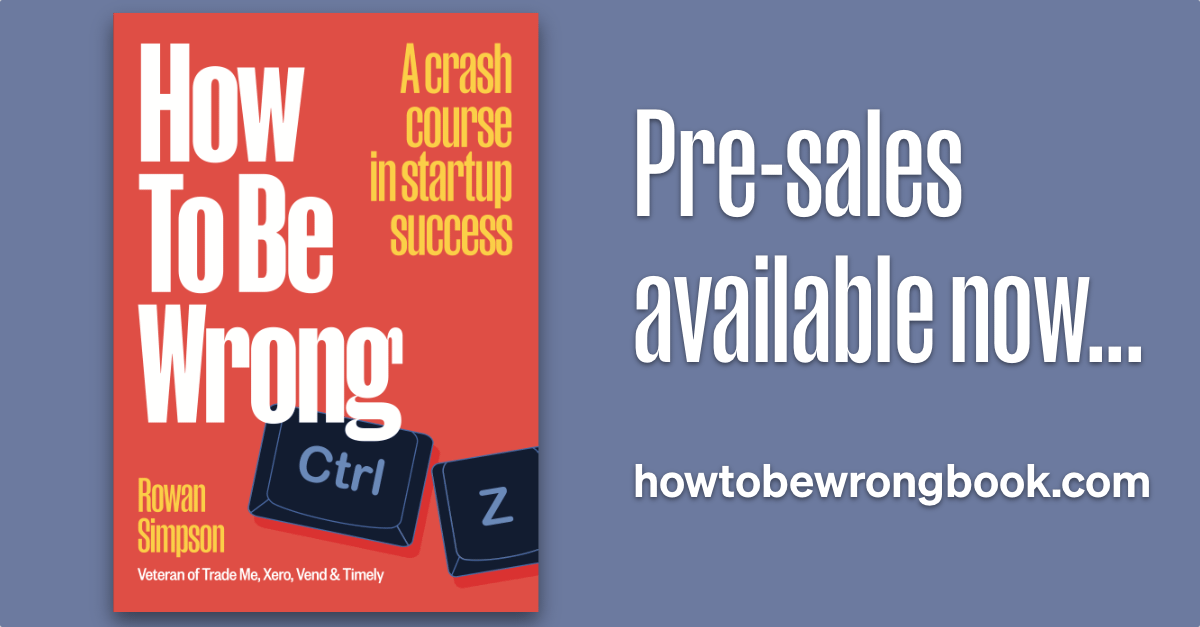2nd February 2025
🧨 Reset 🧱 Build 📚 Summarise
In case you missed the news, pre-sales for my book How To Be Wrong are now underway. If you want to grab a copy of the special “First 500” edition, which are individually signed and numbered, please get in quick - nearly half of them are already sold.
There are also discounted bundles for anybody purchasing multiple copies, which include free merchandise, like Ctrl-Z t-shirts and caps.
If you prefer to buy from a real bookstore, it’s also available to pre-order through my friends at BookHero.co.nz.
I’m only printing a limited number, and once they are sold they are sold. Don’t delay.
🧨 Reset
This opinion piece was first published in The Spinoff on 29 January.
In 2011 the physicist Sir Paul Callaghan, one of New Zealand’s most distinguished scientists and a passionate advocate for economic transformation, gave a landmark speech he called “Sustainable economic growth for New Zealand: An optimistic myth-busting approach”. Many of his observations have become often-repeated mantras of New Zealand’s technology sector, including “be the place where talent wants to live”, “we better be prepared to be good at some pretty weird stuff” (anticipating correctly that the most successful companies would operate in obscure and difficult-to-predict niches) and that “just 100 inspired entrepreneurs could turn this country around”.
Tragically, Callaghan died of cancer just months later. However, his legacy lived on in a new Crown entity called Callaghan Innovation, established in 2013 with the vague responsibility for “making New Zealand business more innovative” through grants, technical services and business support. The intention was noble – to help transform New Zealand from a country dependent on primary industries to one driven by technology and innovation.
Fast forward to last week: prime minister Christopher Luxon’s state of the nation speech echoed many of those same ideas. At the end, he announced that Callaghan Innovation would be disestablished, with its “most important functions” reassigned elsewhere in the public sector.
For those of us who have built and invested in successful technology companies in New Zealand, this decision is overdue. Despite good intentions, the agency became bogged down in administering grants and subsidies rather than driving real innovation. Under pressure to demonstrate value, it spread its resources thinly across a huge range of activities – from managing R&D tax credits to funding startup accelerator programmes. But there was never any clear evidence that any of these initiatives actually helped create more successful companies.
There’s no question that improving our productivity and growing the economy beyond agriculture and tourism is key to our future prosperity. We’ve understood this for a long time. However, the ambition to be more innovative has never been our problem. The challenge we’ve struggled with all these years is actually doing it in any measurable way. Perhaps we missed a trick? Rather than Callaghan Innovation we should have called it Callaghan Execution.
Having worked with and invested in companies like Trade Me, Xero, Vend and Timely over the past two decades, I’ve seen firsthand what drives growth. The key question is always: What’s the constraint? What’s actually holding us back? As we consider the legacy of Callaghan Innovation, and more importantly think about what will replace it, let’s ask the same question of our economy as a whole.
Here’s an obvious answer: our national obsession with investing in real estate, rather than investing in much more uncertain but ultimately more rewarding productive businesses. Spending more and more borrowed money to buy little bits of our country off each other is a zero-sum game. We might think it’s how we “get ahead”, but it’s actually dragging us down.
Luxon himself exemplifies this – he’s often described as a “businessman”, but his investments after achieving financial success were rental properties, sold for profit years later. What kind of business is that? What value does it create?
Here’s another: our expectation that the government will underwrite business risk, while private shareholders capture the rewards. Founders and executives at early-stage companies spend countless hours pursuing grants, subsidies, R&D credits and development loans – many of which end up written off rather than repaid. Venture funds and “angel investors” expect government co-investment without hard questions. The government venture fund has been tilting at windmills for more than 20 years, with little to show for hundreds of millions invested.
Ask not what you can do for your country, but what your country can do for you, I suppose?
Here’s a third: our dismal savings record, which leaves us constantly looking overseas for investment. In the same speech last week the prime minister announced the creation of Invest New Zealand to “roll out the welcome mat” for foreign investors. But lack of a welcome mat hasn’t constrained our best startups from attracting international investment – companies like Xero, Vend and Rocket Lab have all raised millions offshore. Many of the most promising companies in the next wave of startups are already backed by Australian-based venture capital funds – including Tracksuit, Halter and OpenStar.
The big difference between New Zealand and Australia in this respect is that in recent years large superannuation funds in Australia have become significant investors in their venture capital sector, helping them to scale. In New Zealand we’re at least a generation behind because we’ve been so tentative on compulsory superannuation. If we had to pick one policy prescription to help us close the gap with Australia, matching their settings on this would be a great first step. Is there any politician here brave enough to propose that?
I applaud the prime minister for turning our attention back to these fundamental questions about New Zealand’s economic future. But aspiration alone is insufficient. What are we actually going to do differently?
Rather than simply targeting “more startups, more IPOs, more inbound foreign investment” – which are inputs – we should understand and measure how startup companies contribute to the broader economy. This means tracking metrics like how much they pay their employees and how much of the capital they raise is spent locally. After all, we don’t tax capital gains in New Zealand, but we do tax operating expenses through PAYE and GST. The only companies that will drive our future prosperity are those that create high-paying local jobs and sustainable growth.
The end of Callaghan Innovation is a necessary reset. While it’s difficult news for those affected, hopefully many of them can find roles working directly for our fastest-growing companies, which are constantly seeking skilled workers, rather than supporting them indirectly. That’s one of our biggest constraints – we need more New Zealanders choosing to work on and invest directly in these businesses. Perhaps then we can move beyond talking about the theoretical benefits of innovation to actually delivering it.
🧱 Build
After the reset comes the rebuild.
In 2006 we visited Berlin and took this obligatory tourist photo at the remains of the Berlin Wall. Little did I realise at the time the significance of the Erich Fried quote I was standing in front of:
Wer will, dass die Welt so bleibt, wie sie ist, der will nicht, dass sie bleibt.
Which translates to:
He who wants the world to remain as it is does not want it to remain at all.
When something isn’t working the correct decision is to stop. That is important, but insufficient. Let’s not waste much more energy debating what got us here. The way more interesting question is what are we going to try next?
Whatever it is, let’s agree to start with four questions at the core of the design:
Who does this help?
What constraints do they have?
How do we hope to reduce or remove those constraints for them?
How will we show that it’s working?
Then, maybe, we give ourselves a chance to build something that actually works.
📚 Summarise
Thanks to everybody who followed the Top Three Summer Series during December and January. If you missed them and you’re short of time to read, I’ve asked two imaginary podcast friends to summarise the whole series:
Up to you to judge if this is generated slop or useful content. I think they got it mostly right. But, I did laugh out loud at this line:
AI is being slapped onto everything these days!
The full series is here:
Aim … Fire 8th December
Feedback Loops 15th December
A sky full of stars 22nd December
Invisible technology 5th January
Getting ahead 12th January
Turpentine 19th January
Enjoy.
PS Last weekend the NZ Herald published this excerpt chapter, about the sale of Trade Me to Fairfax Media for $750 million in 2006.






Great post. The task for the country is simple when you've laid it out like this, but not easy. In different times perhaps this govt's 'manage the books' policies might have been good (I'm trying to be open minded) but they have not recognised they came in at almost a 'now or never' point left to them my all previous governments. A fork in the road and we've taken the wrong one. Unless we can get the agriculture sector to also recognise the long term problem rather than trying to protect their turf we're never going to make it.
Good luck with persuading this government to provide settings to encourage risk investment. Everything it’s done so far has been to reinforce the message that the sensible investment is residential real estate. The government even discourages investment in industrial real estate to house new ventures, the most conservative end of the venture world.
This government is all talk. We will be no further ahead when they’re thrown out.